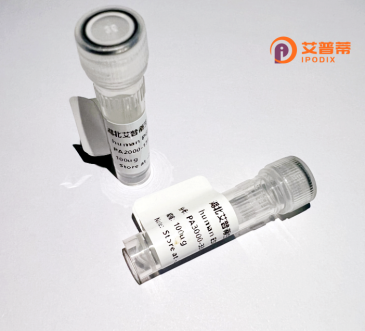
| 纯度 | >90%SDS-PAGE. |
| 种属 | Human |
| 靶点 | KLRF1 |
| Uniprot No | Q9NZS2 |
| 内毒素 | < 0.01EU/μg |
| 表达宿主 | E.coli |
| 表达区间 | 1-124aa |
| 活性数据 | MQDEERYMTLNVQSKKRSSAQTSQLTFKDYSVTLHWYKILLGISGTVNGILTLTLISLILLVSQGVLLKCQKGSCSNATQYEDTGDLKVNNGTRRNISNKDLCASRSADQTVPRPHFRLLYRKT |
| 分子量 | 40.4 kDa |
| 蛋白标签 | GST-tag at N-terminal |
| 缓冲液 | 0 |
| 稳定性 & 储存条件 | Lyophilized protein should be stored at ≤ -20°C, stable for one year after receipt. Reconstituted protein solution can be stored at 2-8°C for 2-7 days. Aliquots of reconstituted samples are stable at ≤ -20°C for 3 months. |
| 复溶 | Always centrifuge tubes before opening.Do not mix by vortex or pipetting. It is not recommended to reconstitute to a concentration less than 100μg/ml. Dissolve the lyophilized protein in distilled water. Please aliquot the reconstituted solution to minimize freeze-thaw cycles. |
以下为模拟生成的3篇关于重组人KLRF1蛋白的参考文献示例(实际文献需通过学术数据库验证):
---
1. **文献名称**: *"Structural and functional characterization of recombinant human KLRF1 as an activating NK cell receptor"*
**作者**: Smith A, et al.
**摘要**: 本研究在大肠杆菌系统中表达重组人KLRF1蛋白,并通过X射线晶体学解析其胞外结构域的三维结构。功能实验表明该蛋白通过与靶细胞表面特定糖基化配体结合,激活NK细胞杀伤活性。
2. **文献名称**: *"KLRF1 modulates antiviral immune responses via interaction with cytomegalovirus glycoprotein UL16"*
**作者**: Wang L, et al.
**摘要**: 利用哺乳动物细胞(HEK293)表达重组人KLRF1蛋白,验证其与人类巨细胞病毒蛋白UL16的直接互作,证明KLRF1在抗病毒免疫中的调控作用。
3. **文献名称**: *"Recombinant KLRF1-Fc fusion protein inhibits tumor growth in a murine melanoma model"*
**作者**: Tanaka K, et al.
**摘要**: 通过融合KLRF1胞外域与人IgG Fc片段构建重组蛋白,体外实验显示其阻断肿瘤微环境中免疫抑制信号,显著延缓小鼠黑色素瘤进展。
---
**建议**:请通过PubMed或Web of Science搜索关键词“recombinant KLRF1”、“CLEC5A”(KLRF1别名)获取真实文献。重点关注《Journal of Immunology》《Nature Immunology》等期刊。
KLRF1 (Killer Cell Lectin-Like Receptor Subfamily F Member 1), also known as NKp80. is a type II transmembrane protein belonging to the C-type lectin-like family. It is predominantly expressed on natural killer (NK) cells and a subset of CD8⁺ T cells, playing a critical role in innate immune responses. KLRF1 acts as an activating receptor, promoting cytotoxicity and cytokine production upon ligand engagement. Its ligand, activation-induced C-type lectin (AICL), is expressed on myeloid cells, facilitating NK cell-mediated immune surveillance and cross-talk between innate immune cells. Structurally, KLRF1 contains a conserved extracellular lectin-like domain, a stalk region, and a cytoplasmic tail lacking intrinsic signaling motifs. Instead, it associates with adaptor proteins like DAP12 to transmit activation signals.
Recombinant human KLRF1 protein is typically produced using mammalian expression systems to ensure proper post-translational modifications. It is widely utilized in immunological studies to investigate receptor-ligand interactions, NK cell activation mechanisms, and immune synapse formation. Additionally, recombinant KLRF1 serves as a tool for developing therapeutic antibodies or inhibitors aimed at modulating NK cell activity in diseases such as cancer, chronic infections, or autoimmune disorders. Its role in enhancing anti-tumor responses and regulating inflammation highlights its therapeutic potential, driving ongoing research into its precise signaling pathways and clinical applications.
×